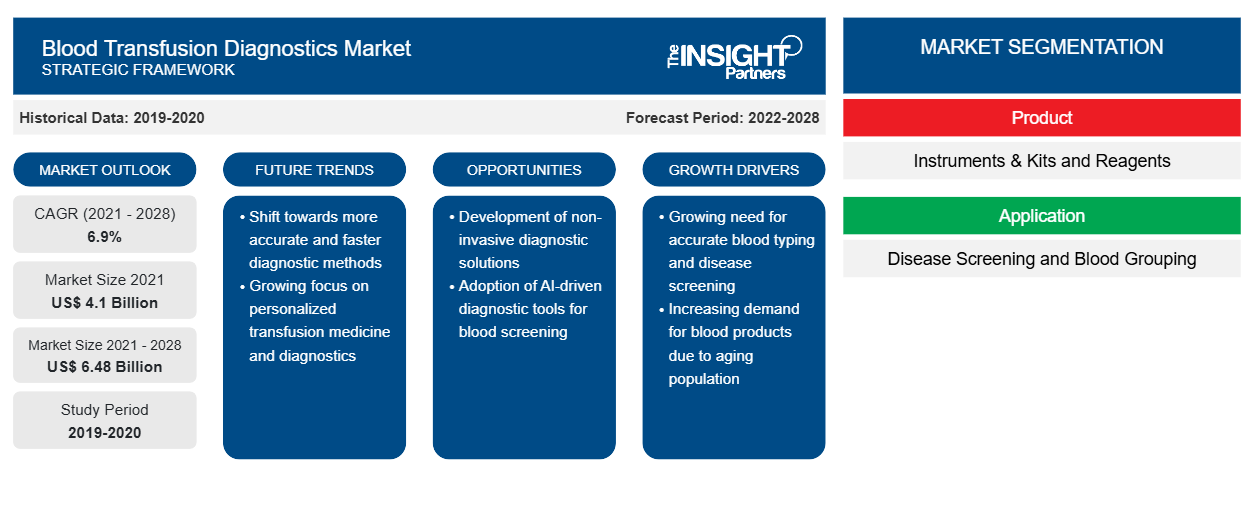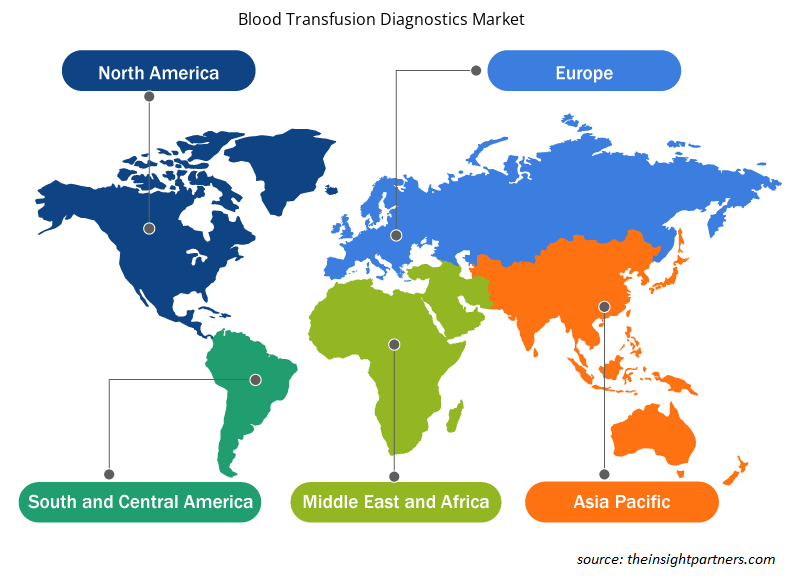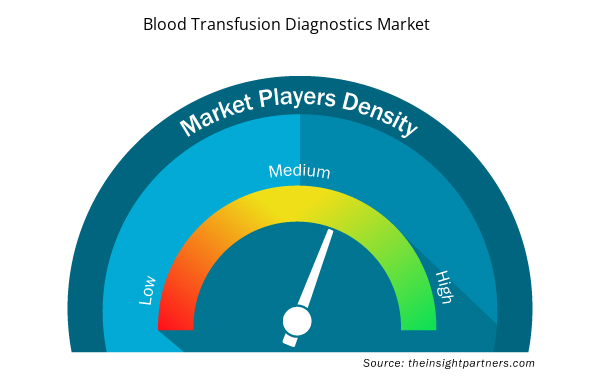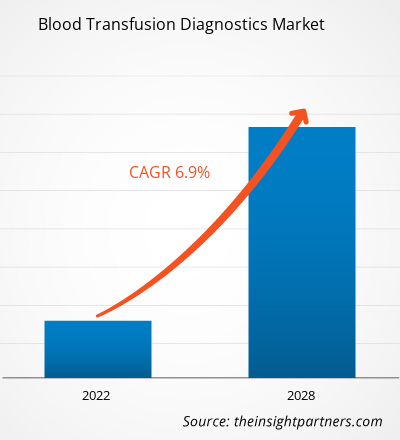[Research Report] The blood transfusion diagnostics market is expected to grow from US$ 4,096.93 million in 2021 to US$ 6,483.75 million by 2028. It is estimated to grow at a CAGR of 6.9% from 2022 to 2028.
Blood transfusion diagnostics are tests performed on blood before they are transfused to patients. A blood transfusion is a common procedure in which the donated blood or its components are transfused into the patient’s body through an intravenous route of administration. Each unit of blood must undergo blood typing, which refers to identification of blood type and blood screening, including disease detection tests to avoid side effects or transmission of infection.
The report offers insights and in-depth analysis of the global blood transfusion diagnostics market, emphasizing various parameters, including market trends, technological advancements, market dynamics, and competitive landscape analysis of global leading market players. It also includes the impact of the COVID-19 pandemic on the market across all regions. The COVID-19 pandemic negatively impacted the global blood transfusion diagnostics market growth. It showcased a huge decline in revenue due to stringent restrictions imposed by the government resulting in decreasing number of surgical procedures performed. These services are mainly used in surgeries with high blood loss, such as orthopedic and cardiac surgeries. Due to decreasing number of surgeries performed, the demand for blood transfusion has reduced. For Instance: According to the data published by American Medical Association, it was estimated that there was a 48% reduction in total surgical procedures performed in the US due to the COVID-19 pandemic. However, after the pandemic restrictions normalized, the volume of surgical procedures returned to normal levels.
Customize This Report To Suit Your Requirement
You will get customization on any report - free of charge - including parts of this report, or country-level analysis, Excel Data pack, as well as avail great offers and discounts for start-ups & universities
Blood Transfusion Diagnostics Market: Strategic Insights

- Get Top Key Market Trends of this report.This FREE sample will include data analysis, ranging from market trends to estimates and forecasts.
Customize This Report To Suit Your Requirement
You will get customization on any report - free of charge - including parts of this report, or country-level analysis, Excel Data pack, as well as avail great offers and discounts for start-ups & universities
Blood Transfusion Diagnostics Market: Strategic Insights

- Get Top Key Market Trends of this report.This FREE sample will include data analysis, ranging from market trends to estimates and forecasts.
Geography-Based Insights
By geography, the global blood transfusion diagnostics market is segmented into North America (the US, Canada, and Mexico), Europe (France, Germany, the UK, Spain, Italy, and the Rest of Europe), Asia Pacific (China, India, Japan, Australia, South Korea, and the Rest of APAC), the Middle East & Africa (Saudi Arabia, the UAE, South Africa, and the Rest of the MEA), and South & Central America (Brazil, Argentina, and the Rest of South & Central America).
Market Insights
Need for Blood Transfusion due to Rise in Organ Transplants Surgeries
Organ transplant is a surgical procedure performed in case of organ failure. Usually, organ transplant surgeries are conducted for the heart, liver, kidney, and various other organs due to the rising cases of chronic diseases, such as chronic kidney disease (CKD), polycystic kidney disease, cystic fibrosis, and congenital heart disease, which require transplants. These procedures generally take hours, and there is a lot of blood loss and requires the need for blood transfusion. For instance, according to the United Network for Organ Sharing (UNOS), organ transplants conducted in the US have continuously increased, with over 41,000 transplants performed in 2021. Similarly, according to World Transplant Registry data, Spain accounted for 20% of all organ donations in Europe in 2019 and 6% worldwide. Australia's organ donor rate has improved recently, rising to 21.8 donors per million population in 2019.
Similarly, Canada has 22.2 donors per million population and is steadily improving, partially attributed to the "Donation Physicians" figure—intensive care doctors responsible for organ donation. According to the World Transplant Registry, China had 5,818 donors in 2019, or 4.1 per million population, and India had 715 donors, or 0.5 per million population in 2019. On the other hand, Russia had a slightly higher rate of 5.1 donors per million people. The public-private partnership, in collaboration with transplant coordinators, has significantly contributed to the improvement of organ transplants requiring constant blood transfusion. Both developing and developed countries have seen an increase in organ transplant surgeries. For example, developing countries, such as India and Singapore, are emerging as medical tourism destinations in Asia Pacific. Countries are progressing in terms of providing better and advanced medical treatments. The rising need for organ transplants is among the key factors driving the demand for blood transfusion diagnostics worldwide.
Product-Based Insights
Based on product, the global blood transfusion diagnostics market is bifurcated into instruments & kits and reagents. In 2021, the instruments & kits segment accounted for a larger market share. The same segment is expected to register a higher CAGR in the market from 2022 to 2028.
Application-Based Insights
Based on application, the global blood transfusion diagnostics market is bifurcated into disease screening and blood grouping. The disease screening segment held a larger market share in 2021 and is expected to register a higher CAGR during the forecast period.
Blood Transfusion Diagnostics Market Regional Insights
Blood Transfusion Diagnostics Market Regional Insights
The regional trends and factors influencing the Blood Transfusion Diagnostics Market throughout the forecast period have been thoroughly explained by the analysts at Insight Partners. This section also discusses Blood Transfusion Diagnostics Market segments and geography across North America, Europe, Asia Pacific, Middle East and Africa, and South and Central America.

- Get the Regional Specific Data for Blood Transfusion Diagnostics Market
Blood Transfusion Diagnostics Market Report Scope
| Report Attribute | Details |
|---|---|
| Market size in 2021 | US$ 4.1 Billion |
| Market Size by 2028 | US$ 6.48 Billion |
| Global CAGR (2021 - 2028) | 6.9% |
| Historical Data | 2019-2020 |
| Forecast period | 2022-2028 |
| Segments Covered |
By Product
|
| Regions and Countries Covered | North America
|
| Market leaders and key company profiles |
Blood Transfusion Diagnostics Market Players Density: Understanding Its Impact on Business Dynamics
The Blood Transfusion Diagnostics Market market is growing rapidly, driven by increasing end-user demand due to factors such as evolving consumer preferences, technological advancements, and greater awareness of the product's benefits. As demand rises, businesses are expanding their offerings, innovating to meet consumer needs, and capitalizing on emerging trends, which further fuels market growth.
Market players density refers to the distribution of firms or companies operating within a particular market or industry. It indicates how many competitors (market players) are present in a given market space relative to its size or total market value.
Major Companies operating in the Blood Transfusion Diagnostics Market are:
- Grifols, S.A.
- F. Hoffmann-La Roche Ltd
- Immucor, Inc.
- Bio-Rad Laboratories Inc.
- Abbott
Disclaimer: The companies listed above are not ranked in any particular order.

- Get the Blood Transfusion Diagnostics Market top key players overview
End User-Based Insights
Based on end user, the global blood transfusion diagnostics market is segmented into blood banks, hospitals, diagnostic laboratories, and plasma fractionation companies. The blood banks segment held the largest market share in 2021. The same segment is expected to register the highest CAGR in the market from 2022 to 2028.
The global blood transfusion diagnostics market players take up organic strategies, including product launch and expansion, to expand their footprint and product portfolio worldwide and meet the growing demand. The key players in the market are Grifols, S.A.; F. Hoffmann-La Roche Ltd; Immucor, Inc.; Bio-Rad Laboratories, Inc.; Abbott; Thermo Fisher Scientific Inc.; Ortho Clinical Diagnostics; DiaSorin S.p.A.; Quotient Limited; and BAG Diagnostics GmbH.
- Historical Analysis (2 Years), Base Year, Forecast (7 Years) with CAGR
- PEST and SWOT Analysis
- Market Size Value / Volume - Global, Regional, Country
- Industry and Competitive Landscape
- Excel Dataset


- Artificial Intelligence in Defense Market
- Oxy-fuel Combustion Technology Market
- Foot Orthotic Insoles Market
- Truck Refrigeration Market
- Artificial Intelligence in Healthcare Diagnosis Market
- Medical Second Opinion Market
- Micro-Surgical Robot Market
- Fish Protein Hydrolysate Market
- Lymphedema Treatment Market
- Grant Management Software Market

Report Coverage
Revenue forecast, Company Analysis, Industry landscape, Growth factors, and Trends

Segment Covered
Product, Application, and End User

Regional Scope
North America, Europe, Asia Pacific, Middle East & Africa, South & Central America

Country Scope
Argentina, Australia, Brazil, Canada, China, France, Germany, India, Italy, Japan, Mexico, Saudi Arabia, South Africa, South Korea, Spain, United Arab Emirates, United Kingdom, United States
Frequently Asked Questions
Global blood transfusion diagnostics market is segmented by region into North America, Europe, Asia Pacific, Middle East & Africa, and South & Central America. In North America, the U.S. is the largest market for blood transfusion diagnostics market. The growth of the market in North America is expected due to the factors such as increasing surgical procedures for chronic health conditions, rising collaborative agreements between key players, and growing progress in the health system for blood transfusion diagnostics. However, the improvement in blood transfusion management, increasing prevalence of sepsis and thalassemia, and the introduction of advanced molecular platforms are the key factor responsible for the Asia-Pacific regional growth for blood transfusion diagnostics accounting fastest growth of the region during the coming years.
Grifols, S.A.; F. Hoffmann-La Roche Ltd; DiaSorin S.p.A.; BAG Diagnostics GmbH; Abbott; Bio-Rad Laboratories, Inc.; Immucor, Inc.; Thermo Fisher Scientific Inc.; Ortho Clinical Diagnostics; and Quotient Limited are among the leading companies operating in the blood transfusion diagnostics market.
The blood banks segment dominated the global blood transfusion diagnostics market and accounted for the largest market share of 40.23% in 2021.
Based on application, disease screening segment took the forefront lead in the worldwide market by accounting largest share in 2021 and is expected to continue to do so till the forecast period.
Based on products, instruments and kits segment took the forefront lead in the worldwide market by accounting largest share in 2021 and is expected to continue to do so till the forecast period.
Blood transfusion diagnostics refers to tests performed on blood and blood components before they are transfused to patients. A blood transfusion is a common procedure in which donated blood or blood components are transfused into the patient's body through an intravenous line (IV). Each unit of blood must undergo blood typing, which refers to the identification of blood type and blood screening, including disease detection tests to avoid side effects or transmission of infection. Blood screening before transfusion is performed through instruments, kits, and reagents to identify various diseases, such as HIV, hepatitis B, hepatitis C, Zika, and different viruses and infections.
Rapid increase in chronic diseases and increasing need for blood transfusion due to rise in organ transplants surgeries are the most significant factors responsible for the overall market growth.
Trends and growth analysis reports related to Life Sciences : READ MORE..
The List of Companies - Blood Transfusion Diagnostics Market
- Grifols, S.A.
- F. Hoffmann-La Roche Ltd
- Immucor, Inc.
- Bio-Rad Laboratories Inc.
- Abbott
- Thermo Fisher Scientific Inc.
- Ortho Clinical Diagnostics
- DiaSorin S.p.A.
- Quotient Limited
- BAG Diagnostics GmbH

 Get Free Sample For
Get Free Sample For